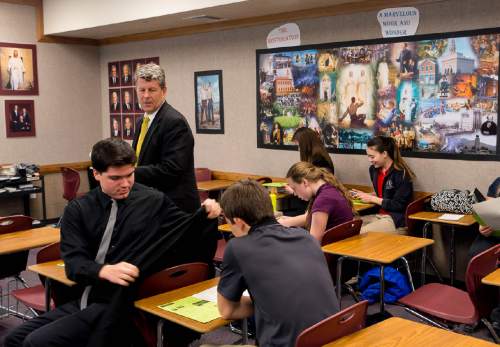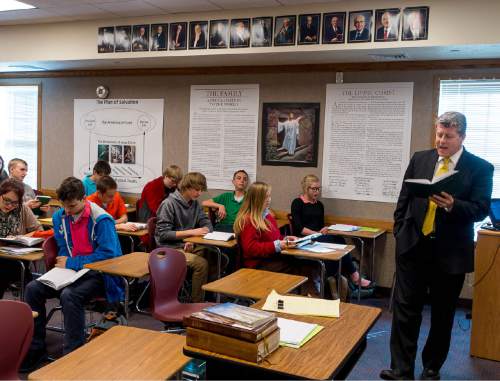This is an archived article that was published on sltrib.com in 2015, and information in the article may be outdated. It is provided only for personal research purposes and may not be reprinted.
South Jordan • Sara Tippetts first attended Mormon seminary in a portable classroom, stationed in a horse pasture next to Paradigm High School.
The classroom was cold in the morning, had squeaky floors and windows that rattled in the wind.
"It was kind of fun," she said. "Well, it wasn't that fun. It was just kind of weird."
Now a senior at the South Jordan charter school, Tippetts and her LDS classmates simply cross the campus parking lot to attend seminary in a building with running water, temperature control and a structural foundation.
It's an amenity taken for granted by most of Utah's Mormon high school students but a relative rarity among charter schools, which are younger and smaller than most of the state's traditional public schools and are prone to sudden relocations, expansions or closures.
Before the LDS Church built the Paradigm seminary building, and before the cold, rickety portable, students met for a brief time in a canopy tent that evoked the Tabernacle of Moses they studied in their sacred scriptures.
"They had to bring in lights and a generator," said Paradigm seminary Principal Jonathan Brinley.
The Church of Jesus Christ of Latter-day Saints administers the seminary program, which provides religious education to secondary-school students as a supplement to Sunday worship services.
In Utah, where the Mormon population is substantial, students are typically excused from school for a period during the day and allowed to leave campus, where seminary buildings are located just outside the legal separation of church and state.
"We try to make sure that youth have options to take seminary wherever they are," said John Monson, a spokesman for the LDS Church's seminary program. "Our goal, and hope, is to help youth deepen their desires to draw closer to Jesus Christ."
But charter schools — alternative schools funded with taxpayer dollars — provide a number of interesting challenges and opportunities, Monson said. When a new charter forms, seminary organizers have to weigh the investment of a new building with the number of potential students and the possibility a school will move or close.
That leads to a natural evolution in which charter students first attend at nearby neighborhood LDS meetinghouses and over time transition to a rented space or a standalone seminary building.
Charter seminaries also offer early-morning classes, common outside Utah but atypical inside the state, due to niche school curriculums that often leave less time for elective courses.
"A lot of it depends on the size of the program and how long the program has been around," Monson said. "As they mature and become larger, quite often we'll build facilities beside them."
Charter school LDS seminaries come in all shapes and sizes around the state. Several years ago, the Ogden Tabernacle hosted charter school students in its basement and Draper's Summit Academy students currently attend seminary inside a nearby business that has free space during the week.
LDS Church spokesman Wayne Davis said Arizona was an early adopter of the charter movement, and church officials experimented there with how to balance the need for seminary facilities with a caution against overextending resources.
"We've learned to reach out as much as we possibly can," he said, "while being cautious not to just jump in and build and build and build."
For Paradigm seminary teacher Brett Miller, teaching in an established building is an improvement over the portable.
He said the former facility's equine neighbors were prone to tampering with outside electrical equipment, and classes were interrupted, particularly in the winter months, by mice.
The desk of a fellow teacher became a home for mice after he lost the keys to a stack of locked drawers.
"He could hear them running around in there," Miller said, "but he couldn't get them out."
While the settings of charter school seminaries may vary, the classroom content remains the same.
Paradigm High School senior Kendall Edmunds has attended seminary classes at both a traditional public school and a charter school. He said there's really no noticeable difference between the two programs.
"They're still teaching the same doctrine of the church."







